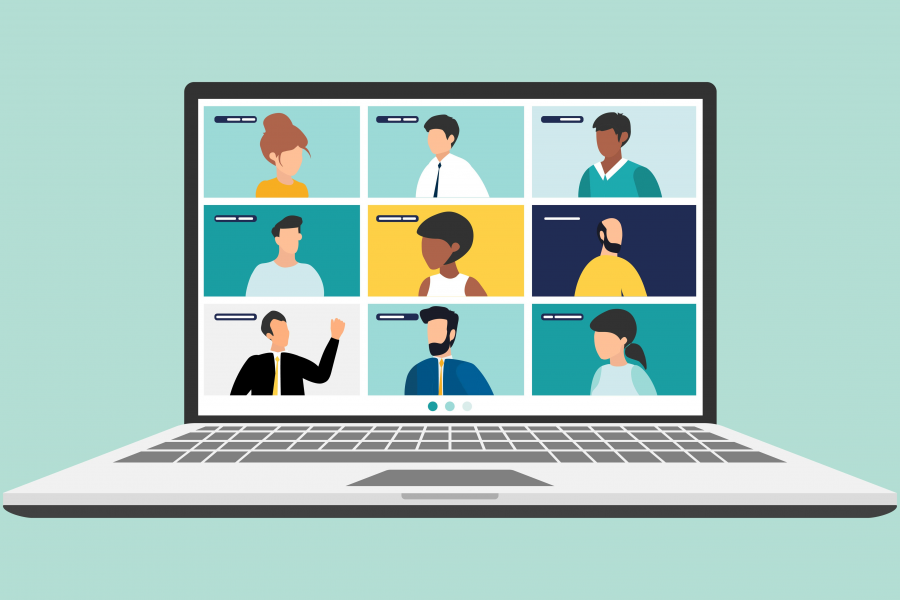Over the past several months, SESYNC’s research teams have met the challenge of shifting their in-person collaborations entirely online with ongoing flexibility, resilience, and commitment. Below, PIs from several of our Pursuits and Graduate Pursuits share the practices they’re using to keep their projects moving forward and to maintain strong connections among their team members.

“I think the most important thing is patience. A tried-and-true remedy, but worth repeating in an online format because of the lack of cues and prompts that we might notice when someone is in front of us. Trying to find a silver lining to the online format, I think that we've had a much easier time planning and scheduling, especially for a meeting during finals season. The ability to split the meeting into two parts also has helped us to have adequate time while not putting too much pressure on either week. While this is in no way a perfect substitute for live and in-person and I wish I could give some sort of magic formula for use of technology, it's really more about just being flexible and rolling with the punches over time.” – Dan Shtob, Co-PI of the graduate-student-led project: From Storms to Plowshares
“Our SESYNC team has joked that remotely working together over the last 3 years set up well for the pandemic. We meet over Skype every 2 weeks. For the first hour, we do check-ins, discuss any pressing issues, and set goals for our work session. We then work together for 2.5 hours after this meeting with our cameras on but muted. This work session carves out time in our busy schedules to focus on our SESYNC project and also makes us feel like we are collectively working together. Also, we can just unmute if questions arise for other team members. In addition to these biweekly meetings, we also maintain an active slack workspace where we do all our communication and a Google Drive folder for collaborative documents and presentations.” – Megan Mills-Novoa, Co-PI of the graduate-student-led project: Agricultural Frontiers
"Get to know each other—we had an introductory call and online Google Doc discussion very early in the project. This allowed everyone to introduce themselves and made sure that everyone understood the project goals. During monthly calls before the meeting, we devoted the first half of every call to a presentation by one of the group members about their work. The second half of the call was devoted to making progress on the project itself. We also drafted a working group code of conduct and defined authorship criteria. Our working group has a mix of “opt-in” and “opt-out” papers—clarifying the process for each paper helps set expectations." – Sarah Weiskopf, Co-PI of the team synthesis project, Diversity in Eco-Function
"We've had regular working meetings to continue to make progress in-between retreat-style, multi-day meetings. Our data crunching members of the team have 1 hr/week set aside to make progress/discuss roadblocks/make decisions; having the multi-day meetings be a mix of discussion and work time was thought of as a success by the team. We also encourage people to set away messages during the multi-day meetings so there are less demands on their time. Giving time to slowly starting the meetings with intentionality, so folks feel heard and not rushed is important. We had already met in person a few times before the pandemic, so we already had modes of communication and checking in established—but I think some time early on spent getting to know each other can be valuable for setting those norms. – Michelle Johnson, Co-PI of the team synthesis project, Urban Woodlands
We have monthly team meetings where we check in about progress and goals, and we also have a weekly recurring work time (same time as the monthly meeting), where subgroups can check in and discuss progress, or people can just join and make a little progress for an hour. I think that's been the most helpful—it's hard to prioritize the Pursuit amongst everything else these days, but having an hour on the schedule every week ensures that we're at least doing something!
One sub-project where we've been making the most progress has been a paper addressing COVID interactions with FEW systems. One of our team members has taken the lead on that, and he's been able to involve some graduate students at his institution to get some of the leg work done. That's been huge.
Overall, we're taking the approach that any progress during these times is an accomplishment, and trying to go easy on ourselves and our team when things don't progress as quickly as they might otherwise." – Rebecca Hale, Co-PI of the team synthesis project, Food-Energy-Water System Typologies
"By this time, everyone is more than used to gathering online. I think we all know the basics—don't let the meetings run too long, take plenty of breaks, use breakout groups to facilitate conversations. Between meetings it seems easier for people's day-to-day work to take over when you don't have the energy of in-person workshops behind you, so following up one-on-one can be helpful. I joined this SESYNC pursuit in January and I've only met one of my team members in person so far. I'm really looking forward to getting to know my colleagues as real 3D humans!" – Rachel Mason, Co–PI of the Pursuit, Global Nitrogen Decline
"One practice we've used in the past is setting up 2-day virtual workshops where we set aside a full workday (more or less) to work on our project. We have a morning check-in and end of day check-in as a team, while during the day we work either alone, in smaller groups, or pairs as necessary. They've been helpful for accelerating progress on our work because we are all working at the same time. I think we've done 3 of them so far (typically about six months apart)." – Celina Balderas, Co-PI of the Pursuit, Watershed Typologies